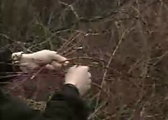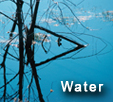First Scientists: Natural Health Products

Streaming Video - High resolution | Low resolution | RealPlayer Help
Transcript of Video
NARRATOR:
Native Canadian medicine is the science of relationships.
NARRATOR:
Gilbert Sewell begins his day by greeting the sun
NARRATOR:
Gilbert collects medicinal plants from around his home in Pabineau, New Brunswick.
He will use this muskrat root to treat sore throats and chest colds.
For Gilbert, how a plant is gathered is as important as the plant itself. Gilbert thanks the land for the medicine by offering tobacco.
NARRATOR:
Tobacco is a sacred currency that reinforces the relationship between the patient, the healer, medicines and the land.
Because part of a healer's responsibility is to keep the land healthy too.
NARRATOR:
Labrador tea is used for upset stomachs.
NARRATOR:
Red willow bark contains compounds similar to aspirin.
Close by is wintergreen, a heart medicine.
GILBERT SEWELL:
For us the woods is like our pharmacy. We don't have to run down to the store every time we have an ailment. It doesn't cost you anything. All you have to know is where to pick it. And if you don't know where to pick it go to an elder. Give him some tobacco and say, look, could you help me and show me the ways of the Mi'kmaq people.
NARRATOR:
Each plant is prepared and preserved in its own way.
Some processes take weeks.
NARRATOR:
Raymond is looking for his father-in-law's help to quit smoking.
NARRATOR:
Gilbert uses ceremonies to focus Raymond's commitment to healing.
NARRATOR:
Worldwide, the natural health business is booming.
NARRATOR:
In response, Health Canada is revamping its regulations for natural health products. It carried out extensive consultations with aboriginal communities. At first this initiative met some resistance.
PHIL WADDINGTON:
Super: Phil Waddington, Health Canada
Many of the people that are within the Aboriginal community are concerned that we are actually going to be taking the information from them. And that is not what we will be doing. It is only if somebody brings that information and says "I want to take this product and move it to the mass market," that we'd be looking at having our regulations apply.
NARRATOR:
Products based on Native medicines are already beginning to show up in the mass market.
RICK STEWART:
Super: Rick Stewart, Lakota Herbal Products
The world wide market is in the billons, and billons, and billons of dollars.
They want to be a part of the herbal game. They look at everybody making all this money and they say "Hey, ya know, a lot of this is our knowledge." Like echinacea is the number one selling herb in the world today. Right? And yet they have no piece of it.
NARRATOR:
Health Canada's new regulations focus on labelling. They recognize the patient's right to decide what they are taking. And to know what evidence shows that a product is safe and actually works.
PHIL WADDINGTON:
The standards of evidence that would be applied, would be proportional to the degree of risk associated with the product. So for example if a product was going to treat colds and flu's, then basing that on traditional literature, most people are comfortable with that. If you're going to treat something a bit more life threatening or is more serious in its outcome, then you would have to have more evidence to be able to support it.
NARRATOR:
But Native medicine may present other challenges. It's an integrated practice. And the effectiveness of a particular remedy has as much to do with the healer and the patient as with active ingredients.
MICHAEL MITCHELL:
Super: Michael Kanentakeron Mitchell, executive director, Centre for Nation Building
I can't see the white race going that far or having that kind of patience. And that's why they say "Can we bottle this? Can we put this in pill form?" Probably not.
PHIL WADDINGTON:
What they've said is that you can't take a product out of the practise of medicine and make it a traditional cure. The interaction that goes on between the healer and the person that comes to that healer for help, the presentation of the medicine, the way that it is gathered. It is a very spiritual medium in which to two work together. And to take that and sterilize it and put it in a bottle and sit it on the shelf. One thing that we have heard very regularly, from within the community, is that you can't really do that.






